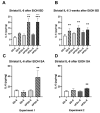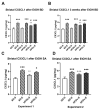Pairing Binge Drinking and a High-Fat Diet in Adolescence Modulates the Inflammatory Effects of Subsequent Alcohol Consumption in Mice
- PMID: 34067897
- PMCID: PMC8157004
- DOI: 10.3390/ijms22105279
Pairing Binge Drinking and a High-Fat Diet in Adolescence Modulates the Inflammatory Effects of Subsequent Alcohol Consumption in Mice
Abstract
Alcohol binge drinking (BD) and poor nutritional habits are two frequent behaviors among many adolescents that alter gut microbiota in a pro-inflammatory direction. Dysbiotic changes in the gut microbiome are observed after alcohol and high-fat diet (HFD) consumption, even before obesity onset. In this study, we investigate the neuroinflammatory response of adolescent BD when combined with a continuous or intermittent HFD and its effects on adult ethanol consumption by using a self-administration (SA) paradigm in mice. The inflammatory biomarkers IL-6 and CX3CL1 were measured in the striatum 24 h after BD, 3 weeks later and after the ethanol (EtOH) SA. Adolescent BD increased alcohol consumption in the oral SA and caused a greater motivation to seek the substance. Likewise, mice with intermittent access to HFD exhibited higher EtOH consumption, while the opposite effect was found in mice with continuous HFD access. Biochemical analyses showed that after BD and three weeks later, striatal levels of IL-6 and CX3CL1 were increased. In addition, in saline-treated mice, CX3CL1 was increased after continuous access to HFD. After oral SA procedure, striatal IL-6 was increased only in animals exposed to BD and HFD. In addition, striatal CX3CL1 levels were increased in all BD- and HFD-exposed groups. Overall, our findings show that adolescent BD and intermittent HFD increase adult alcohol intake and point to neuroinflammation as an important mechanism modulating this interaction.
Keywords: alcohol; binge; binge drinking; cytokines; high-fat diet; inflammation; microbiota.
Conflict of interest statement
The authors declare no conflict of interests.
Figures







Similar articles
-
Intermittent and limited exposure to a high-fat diet prevents social defeat-induced increase in ethanol intake and neuroinflammation.Food Funct. 2025 Jun 16;16(12):5133-5150. doi: 10.1039/d5fo00584a. Food Funct. 2025. PMID: 40468831
-
Access schedules mediate the impact of high fat diet on ethanol intake and insulin and glucose function in mice.Alcohol. 2020 Aug;86:45-56. doi: 10.1016/j.alcohol.2020.03.007. Epub 2020 Mar 26. Alcohol. 2020. PMID: 32224218 Free PMC article.
-
Emotional memory impairment produced by binge drinking in mice is counteracted by the anti-inflammatory indomethacin.Behav Brain Res. 2020 Mar 2;381:112457. doi: 10.1016/j.bbr.2019.112457. Epub 2019 Dec 28. Behav Brain Res. 2020. PMID: 31891744
-
Obesity and binge alcohol intake are deadly combination to induce steatohepatitis: A model of high-fat diet and binge ethanol intake.Clin Mol Hepatol. 2020 Oct;26(4):586-594. doi: 10.3350/cmh.2020.0100. Epub 2020 Sep 17. Clin Mol Hepatol. 2020. PMID: 32937687 Free PMC article. Review.
-
[Neurocognitive anomalies associated with the binge drinking pattern of alcohol consumption in adolescents and young people: a review].Adicciones. 2014;26(4):334-59. Adicciones. 2014. PMID: 25578003 Review. Spanish.
Cited by
-
Differential proteomic analysis of mouse cerebrums with high-fat diet (HFD)-induced hyperlipidemia.PeerJ. 2022 Aug 3;10:e13806. doi: 10.7717/peerj.13806. eCollection 2022. PeerJ. 2022. PMID: 35942128 Free PMC article.
-
Acute and Chronic Ethanol Effects during Adolescence on Neuroimmune Responses: Consequences and Potential Pharmacologic Interventions.Cells. 2023 May 18;12(10):1423. doi: 10.3390/cells12101423. Cells. 2023. PMID: 37408257 Free PMC article. Review.
-
High-Fat Diet Augments the Effect of Alcohol on Skeletal Muscle Mitochondrial Dysfunction in Mice.Nutrients. 2022 Feb 28;14(5):1016. doi: 10.3390/nu14051016. Nutrients. 2022. PMID: 35267991 Free PMC article.
-
Vicarious Social Defeat Increases Conditioned Rewarding Effects of Cocaine and Ethanol Intake in Female Mice.Biomedicines. 2023 Feb 9;11(2):502. doi: 10.3390/biomedicines11020502. Biomedicines. 2023. PMID: 36831038 Free PMC article.
-
Sensitive Profiling of Mouse Liver Membrane Proteome Dysregulation Following a High-Fat and Alcohol Diet Treatment.Proteomics. 2024 Dec;24(23-24):e202300599. doi: 10.1002/pmic.202300599. Epub 2024 Sep 23. Proteomics. 2024. PMID: 39313981 Free PMC article.
References
-
- World Health Organization [WHO] [(accessed on 18 January 2021)]; Available online: https://apps.who.int/iris/handle/10665/274603.
-
- National Institute on Alcohol Abuse, and Alcoholism [NIAAA] [(accessed on 2 April 2021)]; Available online: https://www.niaaa.nih.gov/publications/brochures-and-fact-sheets/binge-d....
MeSH terms
Substances
Grants and funding
LinkOut - more resources
Full Text Sources
Medical
Research Materials
Miscellaneous

